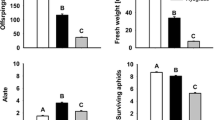Abstract
Most phytophagous insects attack a specific and limited group of host plants. Genuine polyphagous species, being noxious to a great number of different plants, are far less numerous. Specialization of insects to certain host plants implies a close adaptation to the specific properties of the food: (i) The insect must have mechanisms to recognise its host plant among the overwhelming number of non-hosts. Certain properties of the host may act as key stimuli, e.g. a specific shape or plant substances. On the other hand, repellents may hinder the infestation of plants. (ii) Furthermore, the insect has to be physiologically adapted to the characteristic qualities of the food.
Access this chapter
Tax calculation will be finalised at checkout
Purchases are for personal use only
Preview
Unable to display preview. Download preview PDF.
Similar content being viewed by others
References
Ehrhardt, P. 1963. Untersuchungen über Bau und Funktion des Verdauugstraktes von Megoura viciae Bckt. (Aphidae, Homoptera) unter besonderer Berücksichtigung der Nahrungsaufnahme und der Honigtauabgabe. Z. Morph. Ökol. Tiere 52, 597–677.
Hennig, E. 1959. Untersuchungen am Saugakt von Aphis fabae Scop. mit P32. Naturwissenschaften 46, 410–411.
Jördens, D. 1977. Zur Wirkung pflanzlicher Oberflächen-Substanzen auf den Primärbefall durch die Schwarze Bohnenblattlaus, Aphis fabae Scop. (Homoptera: Aphididae). Diss. Faculty of Agriculture, Univ. Bonn, 130 S.
Jördens, D., Klingauf, F. 1977. Der Einfluss von L-Dopa auf Ansiedlung und Entwicklung von Aphis fabae Scop. an synthetischer Diät. Med. Fac. Landbouww. Rijksuniv, Gent, 42/2, 1411–1419.
Kenedy, J.S., Booth, C.O. 1963a. Free flight of aphids in the laboratory, J. Exp. Biol. 40, 67–85.
Kenedy, J.S., Booth, C.O. 1963b. Co-ordination of successive activities in an aphid. The effect of flight on the settling responses. J. Exp, Biol. 40, 351–369.
Kindler, S.D., Staples, R. 1969. Behaviour of the spotted alfalfa aphid on resistant and susceptible alfalfas. J. Econ. Entomol. 62, 474–478.
Klingauf, F. 1972. Modellversuche zum Einfluss der kurzen Pflanzenbesuche auf das Wirtswahlverhalten wâhrend des Befallsfluges von Aphiden. Z. angew. Entomol. 70, 352–358.
Klingauf, F., 1976. Die Bedeutung der “Stimmung” im Leben phytophager Insekten am Beispiel des Wirtswahl-Verhaltens von Blattlâusen. Z. angew. Entomol. 82, 200–209.
Klingauf, F., El-Sayed, A.M.K. Stechborsten-Penetration bei Acyrthosiphon pisum (Harris) und Myzus persicae (Sulz.) (Homoptera, Aphidina) an Blattmodellen mit Saccharose-und pH-Gradienten. (in preparation).
Klingauf, F., Nöcker-Wenzel, K, 1972. Einfluss von Aminoshuren auf das Wirtswahlverhalten von Acyrthosiphon pisum (Homoptera: Aphididae) unter besonderer Berücksichtigung ihres chemischen Aufbaus. Ent. exp. appl. 15, 274–286.
Klingauf, F., Nbcker-Wenzel, K., Röttger, U. 1978. Die Rolle peripherer Pflanzenwachse far den Befall durch phytophage Insekten. Z. Pflanzenkrankh. Pflanzensch. 85, 228–237.
Kring, J.B. 1972. Flight behaviour of aphids. Ann. Rev. Entomol, 17, 461–492.
McMurtry, J.A., Standford, E.H. 1960. Observations of feeding habits of the spotted alfalfa aphid on resistant and susceptible alfalfa plants. J. Econ. Entomol. 53, 714–717.
Mittler, T.E., Dadd, R.H. 1964. Gustatory discrimination between liquids by the aphid Myzus persicae (Sulzer). Ent. exp. appl. 7, 315–328.
Mittler, T.E., Dadd, R.H. 1965. Differences in the probing responses of Myzus per- sicae (Sulzer) elicited by different feeding solutions behind a parafilm membrane. Ent. exp. appl. 8, 107–122.
Moericke, V. 1955. Über die Lebensgewohnheiten der geflúgelten Biâttlause (unter besonderer Berücksichtigung des Verhaltens beim Landen). Z. angew. Entomol. 37, 29–91
Moericke, V., 1969. Hostplant specific colour behaviour by Hyalopterus pruni (Aphi didae). Ent. exp. appl. 12, 524–534.
Müller, F.P. 1969. Aphidina - Blattläuse, Aphiden. In: Stresemann, E.: Exkursionsfauna von Deutschland.Insekten - Zweiter Halbband. Wirbellose II/2. Volk und Wissen, VEV Berlin, 51–141.
Moericke, V., 1970. Zur Kenntnis der Schwarzen Bohnen-oder Rúbenblattlaus vom Gesichtspunkt der Prognose und des Warndienstes. Nachrichtenbl. Deutsch Pflanzenschutzd. DDR, 24, 96–100.
Müller, H.J. 1965. Das Beziehungsgefüge zwischen Blattlâusen und (landwirtschaftlichen) Kulturpflanzen als Beispiel eines Zyklus autokologischer Phasen. Der Züchter 35, 14–24.
Nielson, M.W., Don, H. 1974. Probing behaviour of biotypes of the spotted alfalfa aphid on resistant and susceptible alfalfa clones. Ent. exp. appl. 17, 477–486.
Nöcker-Wenzel-Wenzel, K., Klein, W., Klingauf, F. 1971. Isolierung von Oberflächensubstanzen aus Vicia faba L. im Rahmen von Untersuchungen zur Insekt-Wirtspflanzen Beziehung. Tetrahedron Letters No. 46, 4409–4412.
Petterson, J. 1970. Studies on Rhopalosiphum padi I. Laboratory studies on olfactometric responses to the winter host Prunus padus Lantbruks-Hoegsk. Ann. 36, 381–399.
Pollard, D.G., 1973. Plant penetration by feeding aphids (Hemiptera, Aphidoidea): a review. Bull. Entomol. Res. 62, 631–714.
Tamaki, G., Butt, B.A., Landis, B.J. 1970. Arrest and aggregation of male Myzus persicae. Ann. Entomol. Soc. Amer. 63, 955–960.
Author information
Authors and Affiliations
Editor information
Editors and Affiliations
Rights and permissions
Copyright information
© 1982 ICARDA
About this chapter
Cite this chapter
Klingauf, F.A.J. (1982). Breeding for Resistance to Aphids. In: Hawtin, G., Webb, C. (eds) Faba Bean Improvement. World Crops: Production, Utilization, and Description, vol 6. Springer, Dordrecht. https://doi.org/10.1007/978-94-009-7499-9_30
Download citation
DOI: https://doi.org/10.1007/978-94-009-7499-9_30
Publisher Name: Springer, Dordrecht
Print ISBN: 978-94-009-7501-9
Online ISBN: 978-94-009-7499-9
eBook Packages: Springer Book Archive




